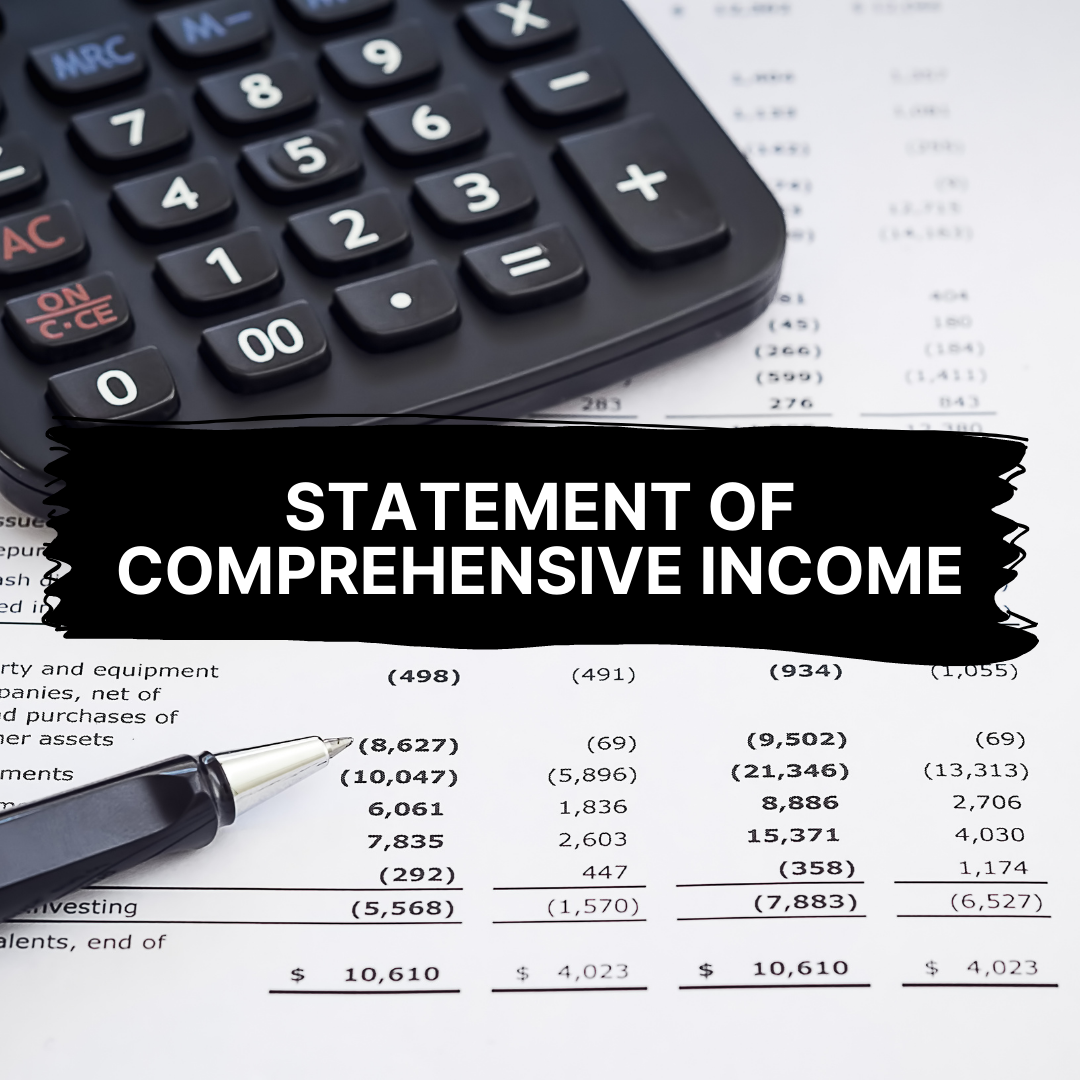Investors almost usually refer to the statement of income when they talk about a company's 'bottom line.' Because this interpretation is so common, most of the investors would be surprised to learn that there is frequently a line below the 'bottom line.'
In fact, there may be a whole subsection of an additional statement of comprehensive income underneath the statement of income. But, what is this statement of comprehensive income and why does it matter so much?
Let’s dig deeper and find out everything about Statement of Comprehensive Income.
What is a Statement of Comprehensive Income?
The income and expenditure items that have not yet been recognized are included in the statement of comprehensive income. It is supposed to complement an organization's income statement by providing a more complete view of a company's financial performance.
Inside the financial statements package, it is usually shown below the income statement, and occasionally on the same page as the income statement.
A smaller company with basic operations may not have been involved in any of the activities that show on a statement of comprehensive income. If this is the case, they are not required to produce the statement.
To put it another way, the statement of comprehensive income includes all sources of revenue. The statement of comprehensive income is made up of two parts: net income and comprehensive income. Other comprehensive income elements come after net income. This statement's bottom line represents comprehensive income rather than net income.
A Closer Look on Comprehensive Income and Its Various Categories
The income statement is one of the most essential parts of the statement of comprehensive income. It includes all revenue and expenditure resources, as well as taxes and interest charges.
However, net income simply takes into account earned income and expenditures. There are instances when organisations accumulate profits or losses as a consequence of changes in the value of their assets that are not reflected in net income. The following are some examples of unrecognized profits or losses:
1. Profit and losses from pension and other related retirement programmes
2. Payments in foreign currencies that have been adjusted
3. Profit and losses from valuation adjustments
4. Profit or losses on debt securities that have not yet been realised
5. Profit or losses on available-for-sale securities that have not yet been realised
It is worth noting that these issues are uncommon in small and medium-sized firms. Larger firms that experience such financial situations are more likely to have OCI items.
The statement of comprehensive income, on the other hand, is calculated by adding net income – which is calculated by adding recognised revenues minus recognised expenses – to other comprehensive income, which includes any unrecognised balance sheet profits and losses that are not included in the income statement.
Advantages of Statement of Comprehensive Income
Let us look at the advantages of comprehensive income:
1. Complete revenue information
The basic aim of an income statement is to show how a firm generates revenue and the expenditures associated with doing so. The revenue statement goes into great depth to emphasise these elements.
It not only explains the cost of sales, which is connected to the operational activities, but it also covers additional expenditures that are not related to the operational activities, such as taxes. Similarly, the income statement records various sources of money that are unrelated to a company's primary operations. This includes things like interest earned on company investments.
2. Investors' analysis method
The income statement is a financial statement that investors look at before deciding whether or not to invest in a firm. The earnings per share, or net earnings, and how it's allocated across the shares outstanding are shown in the financial accounts. The bigger the earnings per share, the more profitable the company is to invest in.
Disadvantages of Statement of Comprehensive Income
Let us look at the disadvantages of comprehensive income:
1. Difficulties in predicting the future
One of the major shortcomings of the statement of comprehensive income is that it cannot forecast a company's future success. The income statement will reflect operational patterns from year to year, but it will not suggest the likelihood or timing of major other comprehensive income items being recorded in the income statement.
2. Falsification of Information
Even though the income statement is a standard tool for measuring a company's financial health, it falls short in key areas. The income statement includes both current earnings from sales and accounts receivables that have yet to be paid to the company.
It also emphasises both current and accumulated expenditures, which are expenses that the firm has yet to pay. However, if a company's assets or liabilities contain a significant unrecognized gain or loss, it might have a significant impact on the company's future sustainability. As a result, relying just on an income statement might be deceptive.
Real-Life Examples for Comprehensive Income
Example 1:
Consider the case of a colleague who won a lottery. Lottery wins are included in their taxed or comprehensive income, although they are not considered normal earned income. This is due to the fact that their lottery wins have nothing to do with their employment or occupation, but they must still be accounted for.
Example 2:
A stock investment made by firm A in firm B is another example. This transaction is recognized at the acquisition price on Firm A's balance sheet and is carried forward until the stock is sold. The entry in the balance sheet, on the other hand, would be incorrect if the stock price increased. Comprehensive income would correct this by revising it to the stock's current market value and recording the difference (in this case, considering it as gains) in the equity column of the balance sheet.
10 Easy Steps to Prepare an Income Statement
You'll need to prepare a performance statement with other financial statements to figure out how much revenue your company has made. Follow the accounting processes mentioned below to create an income statement and report the earnings your firm has generated.
Later, you can add unrecognized profits & losses to get the statement of comprehensive income. Let’s check out the steps:
1. Determine a reporting period
The first step in creating an income statement is deciding on the reporting period for your report. Annual, quarterly, or monthly income statements are the most common choices for businesses. Financial statements must be prepared quarterly and annually for publicly traded corporations, but small businesses are not subject to the same reporting requirements. Monthly income statements can assist you in identifying trends in your profits and expenses over time. This data can assist you in making business decisions that will improve the efficiency and profitability of your firm.
2. Create a Trial Balance Report
You'll need to print a normal trial balance report to generate an income statement for your company. Administrative documents that indicate the end balances of each account in the general ledger for a certain reporting period are known as trial balance reports. Making balance sheets is an important part of making an income statement since it's how a business collects data for account balances. It will provide you with all of the end-of-period numbers you'll need to make an income statement.
3. Estimate Your Profits
After that, you'll need to figure out how much profit your company made throughout the reporting period. If you've not yet got all of the payments, your revenue comprises all of the money generated for your services throughout the reporting period. Sum up all of the items in the revenue line from your trial balance and enter the total amount.
4. Calculate the cost of sales
The direct labour, materials, and overhead charges you spend to supply your goods or services are included in your cost of sales. On your trial balance report, add up all the cost of sales line items and enter the total amount of cost of sales just below the revenue line item on the income statement.
5. Figure out the Gross Margin
On your income statement, deduct the whole cost of goods sold from the total income. The gross margin, or the amount gained from the sale of your goods and services, will be determined by this calculation.
6. Add Operating Expenses
Add up all of your trial balance report's operational expenses. To ensure that you have the correct values, double-check each expense item. In the income statement, enter the whole amount as an item for overhead expenses. It's directly underneath the gross margin line.
7. Estimate Your Income
Reduce the gross margin from the total overhead expenses. This will tell you how much money you have before taxes. The total should go at the lowest part of the income statement.
8. Don't forget to include in income taxes
To compute income tax, multiply your pre-tax income by the appropriate state tax rate. Subtract this from the pre-tax income number on the income statement.
9. Compute your net income
Reduce the income tax from the pre-tax income to arrive at your company's net income. In your income statement, put the figure in the last line item. This will offer you a broad picture of your company's success and allow you to assess how lucrative it has been.
10. Complete your income statement
Add a heading to the report that identifies it as an income statement to complete your income statement. Fill in your company's information as well as the income statement's reporting period. You've now constructed an accurate income statement using all of the information you've gathered. This will offer you a better grasp of income statement definition in the future, which will help you and your organization.
Last Words
The shift in net equity of a business organization over a given period is reported on the statement of comprehensive income. The statement of retained earnings is split into two sections: net income and other comprehensive income (OCI), which includes items that aren't included in the income statement.
It is basically an overall revenue statement that combines the basic income statement, which outlines the company's repetitive operations, and other comprehensive income, which details non-operational payments such as asset sales, patents, and other transactions.
To get a more inside look at an organization, look for other statements that are from previous 10 years of financial records and try to spot a trend. It will assist you in determining the risk-to-reward ratio even before you invest in the company.
Related Articles












